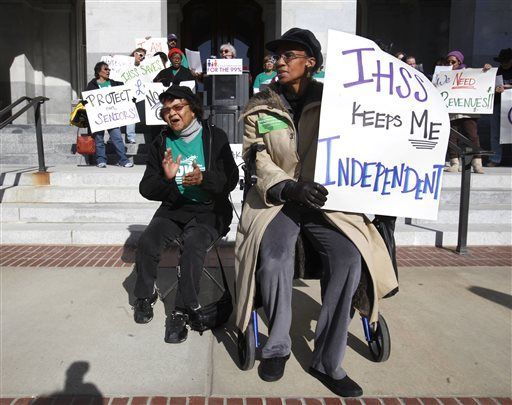
FILE -- In this Jan. 18, 2012 file photo, Metres Huddleston, left, and Sandra Vinning, who both receive care through California's In-Home Supportive Services program, joined others at a rally to protest further cuts to social services, following Gov. Jerry Brown's State of the State speech at the Capitol in Sacramento, Calif. A poll by The Associated Press-NORC Center for Public Affairs Research shows that less than one-third of Californians age 40 and over have heard of the IHSS program,which dates to the 1950's.(AP Photo/Rich Pedroncelli, file)
By Kevin Freking – Associated Press | July 14, 2015
WASHINGTON (AP) — Christine McCormack quit her job as a restaurant manager two years ago to care for her 88-year-old mother-in-law. While it doesn’t make up for all of her lost income, she’s getting some financial help through an innovative program that allows many of California’s low-income senior citizens and disabled residents to remain in their home.
McCormack gets paid $11 an hour through the In-Home Supportive Services Program, which pays family members and other caregivers to help about 467,000 enrollees with such things as housecleaning, bathing, grocery shopping and laundry so they can stay at home rather than move to a nursing home or other care facility.
A poll by the Associated Press-NORC Center for Public Affairs Research shows that less than one-third of Californians age 40 and over have heard of the program, which dates back to the 1950s.
Participants in the program are eligible for Medi-Cal, the state’s Medicaid program. They generally have a monthly income of $877 or below and no more than $2,000 in assets. The program’s elderly and disabled participants hire the person who provides their care, and caregivers can be family members or friends.
Those living in poorer California households do seem more aware of the program than others. Forty-two percent of those with household incomes under $50,000 a year say they have heard of the program compared with 22 percent of those with household incomes of more than $50,000.
Even today, after serving as a caregiver for a sister and now her mother-in-law, McCormack doesn’t think much about planning for her future long-term care needs.
“We live day-to-day with our paychecks,” she said.
Advocacy groups say they’re not surprised that so few people are aware of the program, even though they consider it a national model.
“Most people don’t know anything about long-term care until it is in their face,” said Deborah Doctor, a legislative advocate for Disability Rights California.
Michael Weston, a spokesman at the California Department of Social Services, said the program’s income requirements mean that most Californians will never come in contact with it.
He noted that enrollment has grown by nearly 40 percent over the past 12 years, showing that counties and advocacy groups are helping get the word out to those who could benefit.
In recent years, advocacy groups have voiced some concerns about the lack of training requirements in the program. And caregivers have sought overtime pay, only to be denied after Labor Department regulations requiring overtime and minimum wage protection for home health care workers were overturned.
A clear majority of older Californians support requiring caregivers to undergo formal training. But they are divided on the impact of paying the workers overtime. While a large majority believes overtime pay is at least somewhat likely to lead more qualified people to enter the field and improve working conditions, many also see a troubling tradeoff: Participants might not get the care they need because the state may limit the hours caregivers work to rein in costs.
Caregivers participating in the program take an orientation class and must pass a criminal background check. Dr. Bruce Chernof, president and CEO of the SCAN Foundation, a charity devoted to encouraging independence for senior citizens, said developing training programs is difficult because participants have such a wide array of health conditions, from Alzheimer’s to strokes, for example.
“There isn’t just a standard set of skills, you plug them into everybody, and they’re good to go,” said Chernof, whose foundation paid for the poll.
McCormack, 54, of Woodland, Calif., said she has taken voluntary classes such as CPR and is willing to take more.
Doctor said the disabilities rights group favors voluntary but not mandatory training, and also favors overtime for caregivers. “The work is respectable work,” she said. “It deserves the same degree of respect as other work.”
In the new poll, Hispanics showed the most support for a training requirement at 83 percent, while 80 percent of blacks and 58 percent of whites supported training requirements.
The AP-NORC Center survey was conducted by telephone April 7 to May 15 among a random national sample of 1,735 adults age 40 or older, including 460 California residents age 40 and older, with funding from the SCAN Foundation. Results for the full survey have a margin of sampling error of plus or minus 3.2 percentage points, and results in California have a margin of sampling error of plus or minus 5.4 percentage point.
___
Online: https://www.longtermcarepoll.org
